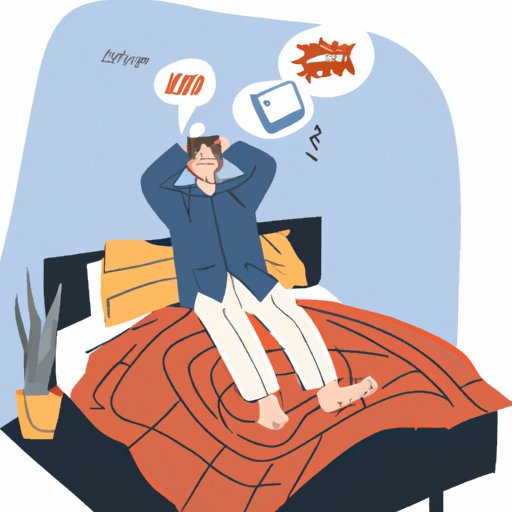
I. Introduction
Panic attacks are a common occurrence and affect approximately 2 to 3 percent of Americans, with women being twice as likely as men to experience them. During a panic attack, individuals may experience a range of emotions and physical symptoms, including a feeling of impending doom, accelerated heart rate, sweating, and chest pain. One of the most common questions regarding panic attacks is whether or not individuals can pass out from them. In this article, we aim to explore the connection between panic attacks and fainting, providing useful information for those who have experienced panic attacks and their loved ones.
II. What are Panic Attacks?
Panic attacks are episodes of intense fear and anxiety, often accompanied by a range of physical symptoms. These episodes can be debilitating and often occur unexpectedly without any apparent reason. Common symptoms of panic attacks include a rapid heartbeat, sweating, shortness of breath, chest pain, trembling, and a feeling of impending doom or death.
Panic attacks can be triggered by a range of things, including stressful life events, a family history of panic attacks, traumatic experiences, and substance abuse. For some individuals, panic attacks may be brought on by specific things, such as driving through tunnels, flying on airplanes, or being in crowded places.
During a panic attack, individuals may experience physical symptoms that mimic those of more severe conditions, including heart attacks or strokes. This can sometimes lead to the fear of passing out.
III. Passing Out from a Panic Attack: How Common Is It?
The risk of passing out from a panic attack is relatively low. According to studies, while fainting is a possible symptom of a panic attack, it only occurs in approximately 3 percent of panic attack cases.
However, there are some potential risks associated with fainting during a panic attack. For example, fainting can lead to injuries, falls, and accidents, particularly if an individual is driving or operating heavy machinery. Fainting can also lead to feelings of embarrassment, humiliation, and low self-esteem, causing the individual to avoid situations or activities that could trigger a panic attack in the future.
IV. Psychological Factors that can Lead to Fainting during a Panic Attack
While the physical symptoms of panic attacks, such as difficulty breathing and chest pain, can certainly be distressing, it is often the psychological aspects of these episodes that are the most challenging to deal with. Psychological factors that can potentially lead to fainting during a panic attack include the fear of losing control and anxiety-induced hyperventilation.
During a panic attack, individuals may fear that they are losing control of their thoughts, emotions, and behavior. This can create a feeling of being trapped or overwhelmed, leading to intense anxiety and panic. Hyperventilation, or breathing too rapidly and shallowly, can lead to a decrease in carbon dioxide levels in the body, causing dizziness, lightheadedness, and potential fainting.
V. How to Manage Panic Attacks and Minimize the Risk of Fainting
There is no one-size-fits-all approach to managing panic attacks. Different individuals may respond differently to various treatments or methods of coping, depending on their personal preferences and experiences. That said, there are several practical tips that can help individuals manage panic attacks and minimize the risk of fainting.
One of the most effective ways to manage panic attacks is through controlled breathing exercises. By taking slow, deep breaths and focusing on the sensation of air moving in and out of the body, individuals can help lower their heart rate, reduce feelings of anxiety, and prevent hyperventilation. Meditation and yoga can also be helpful for managing stress and anxiety and promoting relaxation.
In some cases, medication may be necessary to manage the symptoms of panic attacks. Antidepressants and anti-anxiety medications, such as selective serotonin reuptake inhibitors (SSRIs) and benzodiazepines, can help reduce the frequency and severity of panic attacks for some individuals.
Another effective strategy for managing panic attacks is exposure therapy. In this type of therapy, individuals are gradually exposed to the things that trigger their panic attacks, allowing them to become more familiar with the sensations of anxiety and learn coping mechanisms to confront and manage their fears.
VI. Tips for Friends and Family on Helping Someone Amid a Panic Attack and What to Do in Case of Fainting
For friends and family members of individuals experiencing panic attacks, providing emotional support and understanding is essential. Encourage the individual to try different coping mechanisms and find what works best for them. Remind them that panic attacks are a treatable condition and that there are many resources available to help them manage their symptoms.
If someone faints while experiencing a panic attack, it is crucial to remain calm and seek medical attention if necessary. Try to sit the individual down or lay them on a flat surface to prevent any further injuries. Place a cool cloth on their forehead, and encourage them to drink water. If the fainting episode lasts for more than a few minutes, seek immediate medical attention.
VII. Conclusion
Panic attacks can be a distressing and debilitating condition, and the fear of passing out during an episode can add to the stress and anxiety already felt. However, with proper management techniques and a supportive network of friends and family, individuals can take steps to understand their condition and reduce their symptoms. Remember that panic attacks are a treatable condition, and there is hope for a better quality of life.





